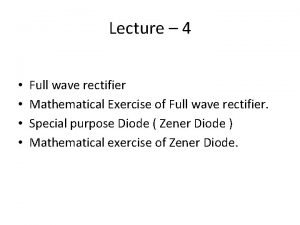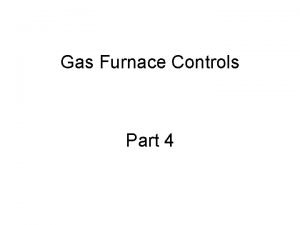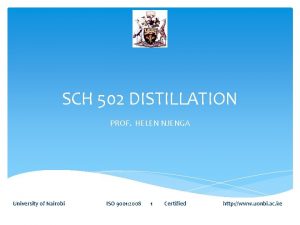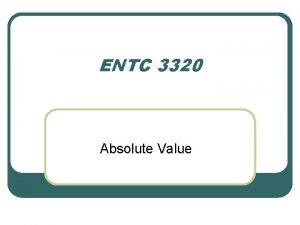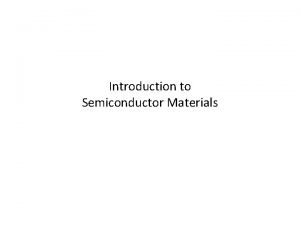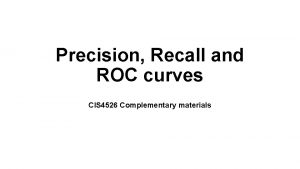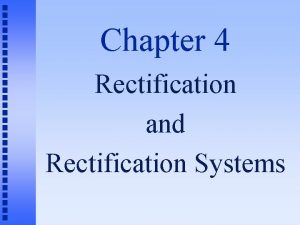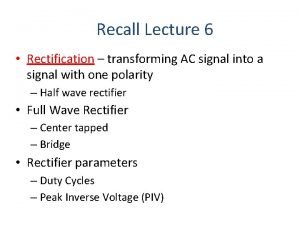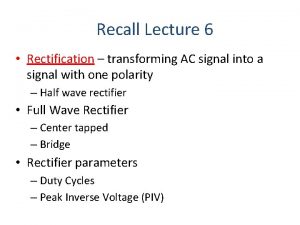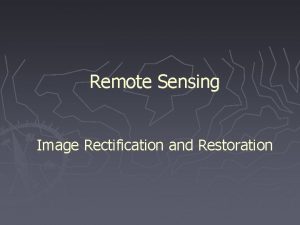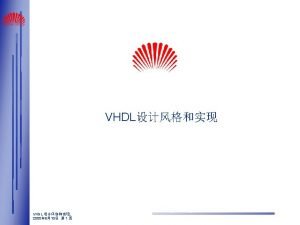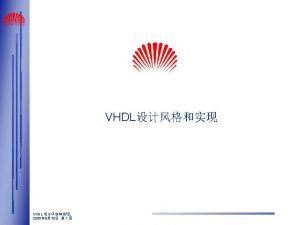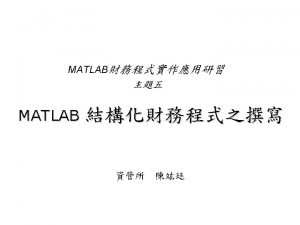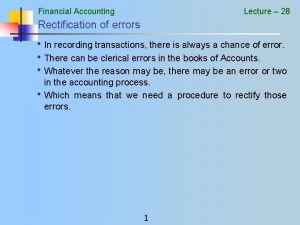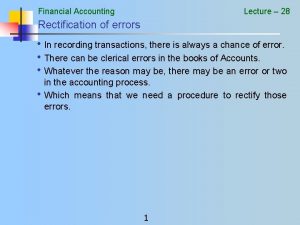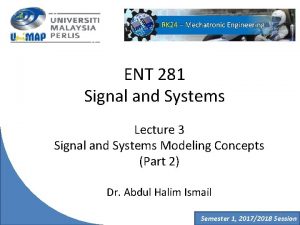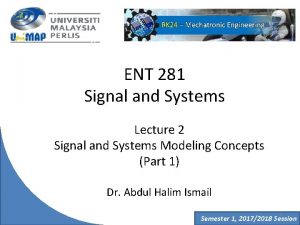Recall Lecture 7 Rectification transforming AC signal into



















- Slides: 19

Recall Lecture 7 • Rectification – transforming AC signal into a signal with one polarity – Half wave rectifier • Full Wave Rectifier – Center tapped – Bridge

Rectifier Parameters Relationship between the number of turns of a step-down transformer and the input/output voltages The peak inverse voltage (PIV) of the diode is the peak value of the voltage that a diode can withstand when it is reversed biased Duty Cycle: The fraction of the wave cycle over which the diode is conducting.

Duty Cycle: The fraction of the wave cycle over which the diode is conducting.

EXAMPLE 1 – Half Wave Rectifier Determine the currents and voltages of the half-wave rectifier circuit. Consider the half-wave rectifier circuit shown in Figure. Assume VB = 6 V, R = 120 Ω , V = 0. 6 V and vs(t) = 18. 6 sin t. Determine the peak diode current, maximum reverse-bias diode voltage, the fraction of the wave cycle over which the diode is conducting. -VR + VB + 18. 6 = 0 VR = 24. 6 V - VR + + A simple half-wave battery charger circuit

This node must be at least 6. 6 V 6 V

The peak inverse voltage (PIV) of the diode is the peak value of the voltage that a diode can withstand when it is reversed biased

Type of Rectifier PIV Half Wave Peak value of the input secondary voltage, vs (peak) Full Wave : Center-Tapped 2 vs (peak)- V Full Wave: Bridge vs (peak) - V

Example: Half Wave Rectifier Given a half wave rectifier with input primary voltage, Vp = 80 sin t and the transformer turns ratio, N 1/N 2 = 6. If the diode is ideal diode, (V = 0 V), determine the value of the peak inverse voltage. 1. Get the input of the secondary voltage: 80 / 6 = 13. 33 V 2. PIV for half-wave = Peak value of the input voltage = 13. 33 V

Example: Full Wave Rectifiers Calculate the transformer turns ratio and the PIV voltages for each type of the full wave rectifier a) center-tapped b) bridge Assume the input voltage of the transformer is 220 V (rms), 50 Hz from AC main line source. The desired peak output voltage is 9 volt; also assume diodes cut-in voltage = 0. 6 V.

Solution: For the centre-tapped transformer circuit the peak voltage of the transformer secondary is required The peak output voltage = 9 V Output voltage, vo = vs - V Hence, vs = 9 + 0. 6 = 9. 6 V this is peak value! Must change to rms value Peak value = Vrms x 2 So, vs (rms) = 9. 6 / 2 = 6. 79 V The turns ratio of the primary to each secondary winding is The PIV of each diode: 2 vs (peak) - V = 2(9. 6) - 0. 6 = 19. 6 - 0. 6 = 18. 6 V

Solution: For the bridge transformer circuit the peak voltage of the transformer secondary is required The peak output voltage = 9 V Output voltage, vo= vs - 2 V Hence, vs = 9 + 1. 2 = 10. 2 V this is peak value! Must change to rms value Peak value = Vrms x 2 So, vs (rms) = 10. 2 / 2 = 7. 21 V The turns ratio of the primary to each secondary winding is The PIV of each diode: vs (peak) - V = 10. 2 - 0. 6 = 9. 6 V


Filters Ø A capacitor is added in parallel with the load resistor of a half-wave rectifier to form a simple filter circuit. At first there is no charge across the capacitor Ø During the 1 st quarter positive cycle, diode is forward biased, and C charges up. Ø VC = VO = VS - V. Ø As VS falls back towards zero, and into the negative cycle, the capacitor discharges through the resistor R. The diode is reversed biased ( turned off) Ø If the RC time constant is large, the voltage across the capacitor discharges exponentially.

Filters Ø During the next positive cycle of the input voltage, there is a point at which the input voltage is greater than the capacitor voltage, diode turns back on. Ø The diode remains on until the input reaches its peak value and the capacitor voltage is completely recharged.

Vp Quarter cycle; capacitor charges up Capacitor discharges through R since diode becomes off VC = Vme – t / RC Input voltage is greater than the capacitor voltage; recharge before discharging again NOTE: Vm is the peak value of the capacitor voltage = VP - V Since the capacitor filters out a large portion of the sinusoidal signal, it is called a filter capacitor.

Ripple Voltage, and Diode Current ØVr = ripple voltage Tp ØVr = VM – VMe -T’/RC T’ where T’ = time of the capacitor to discharge to its lowest value Vr = VM ( 1 – e -T’/RC ) Expand the exponential in series, Vr= ( VMT’) / RC Figure: Half-wave rectifier with smoothing capacitor.

• If the ripple is very small, we can approximate T’ = Tp • Hence for half wave rectifier Vr = ( VMTp) / RC Vr = VM / ( f RC) l For full wave rectifier Vr = ( VM 0. 5 Tp) / RC Vr = VM / ( 2 f RC)

MULTIPLE DIODE CIRCUITS

Example: Cut-in voltage of each diode in the circuit shown in Figure is 0. 65 V. If the input voltage VI = 5 V, determine the value of R 1 when the value of ID 2 = 2 ID 1. Also find the values of VI , ID 1 and ID 2. Assume that all diodes are forward-biased. End of Chapter 3
 Full wave rectifier 4 diodes
Full wave rectifier 4 diodes Gas furnace sequence of operation flow chart
Gas furnace sequence of operation flow chart Rectification using a partially vaporized feed
Rectification using a partially vaporized feed X ray production
X ray production Flame rectification circuit
Flame rectification circuit Absolute value rectification
Absolute value rectification Stock rectification in library
Stock rectification in library Half wave rectifier with transformer
Half wave rectifier with transformer D'arsonval meter movement used with half-wave rectification
D'arsonval meter movement used with half-wave rectification Rectification formula
Rectification formula 01:640:244 lecture notes - lecture 15: plat, idah, farad
01:640:244 lecture notes - lecture 15: plat, idah, farad What is the product of an even signal and odd signal
What is the product of an even signal and odd signal Baseband signal and bandpass signal
Baseband signal and bandpass signal Baseband signal and bandpass signal
Baseband signal and bandpass signal Digital signal as a composite analog signal
Digital signal as a composite analog signal The unit that transforms data into information is the
The unit that transforms data into information is the Transforming data into information in computer
Transforming data into information in computer Precision recall curve
Precision recall curve Total recall vr
Total recall vr Recall bias
Recall bias
